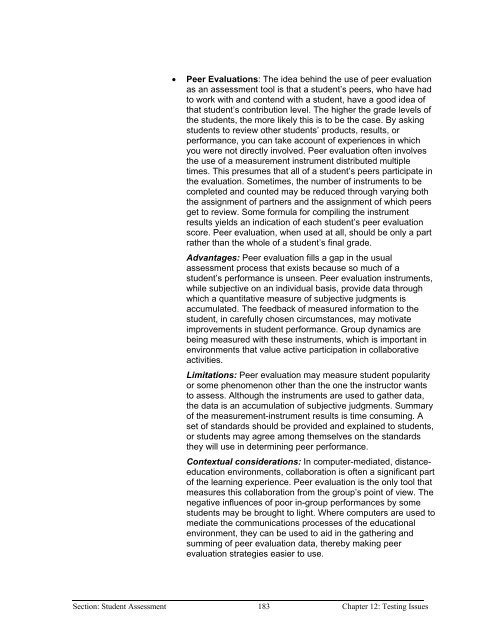Chapter 9 - Instructional Media: Chalkboards to Video - CGISS
Chapter 9 - Instructional Media: Chalkboards to Video - CGISS
Chapter 9 - Instructional Media: Chalkboards to Video - CGISS
Create successful ePaper yourself
Turn your PDF publications into a flip-book with our unique Google optimized e-Paper software.
• Peer Evaluations: The idea behind the use of peer evaluation<br />
as an assessment <strong>to</strong>ol is that a student’s peers, who have had<br />
<strong>to</strong> work with and contend with a student, have a good idea of<br />
that student’s contribution level. The higher the grade levels of<br />
the students, the more likely this is <strong>to</strong> be the case. By asking<br />
students <strong>to</strong> review other students’ products, results, or<br />
performance, you can take account of experiences in which<br />
you were not directly involved. Peer evaluation often involves<br />
the use of a measurement instrument distributed multiple<br />
times. This presumes that all of a student’s peers participate in<br />
the evaluation. Sometimes, the number of instruments <strong>to</strong> be<br />
completed and counted may be reduced through varying both<br />
the assignment of partners and the assignment of which peers<br />
get <strong>to</strong> review. Some formula for compiling the instrument<br />
results yields an indication of each student’s peer evaluation<br />
score. Peer evaluation, when used at all, should be only a part<br />
rather than the whole of a student’s final grade.<br />
Advantages: Peer evaluation fills a gap in the usual<br />
assessment process that exists because so much of a<br />
student’s performance is unseen. Peer evaluation instruments,<br />
while subjective on an individual basis, provide data through<br />
which a quantitative measure of subjective judgments is<br />
accumulated. The feedback of measured information <strong>to</strong> the<br />
student, in carefully chosen circumstances, may motivate<br />
improvements in student performance. Group dynamics are<br />
being measured with these instruments, which is important in<br />
environments that value active participation in collaborative<br />
activities.<br />
Limitations: Peer evaluation may measure student popularity<br />
or some phenomenon other than the one the instruc<strong>to</strong>r wants<br />
<strong>to</strong> assess. Although the instruments are used <strong>to</strong> gather data,<br />
the data is an accumulation of subjective judgments. Summary<br />
of the measurement-instrument results is time consuming. A<br />
set of standards should be provided and explained <strong>to</strong> students,<br />
or students may agree among themselves on the standards<br />
they will use in determining peer performance.<br />
Contextual considerations: In computer-mediated, distanceeducation<br />
environments, collaboration is often a significant part<br />
of the learning experience. Peer evaluation is the only <strong>to</strong>ol that<br />
measures this collaboration from the group’s point of view. The<br />
negative influences of poor in-group performances by some<br />
students may be brought <strong>to</strong> light. Where computers are used <strong>to</strong><br />
mediate the communications processes of the educational<br />
environment, they can be used <strong>to</strong> aid in the gathering and<br />
summing of peer evaluation data, thereby making peer<br />
evaluation strategies easier <strong>to</strong> use.<br />
Section: Student Assessment 183 <strong>Chapter</strong> 12: Testing Issues
















